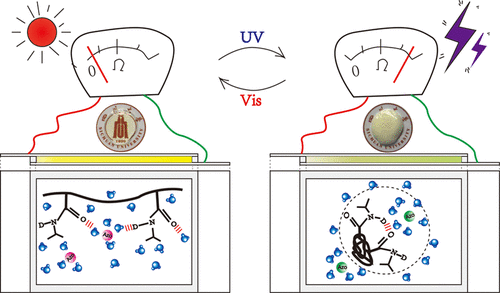当前位置:
X-MOL 学术
›
ACS Macro Lett.
›
论文详情
Our official English website, www.x-mol.net, welcomes your
feedback! (Note: you will need to create a separate account there.)
Azobenzene-Based Ionic Liquid Switches Phase Separation of Poly(N-isopropylacrylamide) Aqueous Solutions as a Molecular Trigger, Leading to UV Shutdown of Ionic Transport
ACS Macro Letters ( IF 5.1 ) Pub Date : 2020-05-20 , DOI: 10.1021/acsmacrolett.0c00170 Peiqi Li 1 , Shuai Tan 1 , Yong Wu 1 , Caihong Wang 1 , Masayoshi Watanabe 2
ACS Macro Letters ( IF 5.1 ) Pub Date : 2020-05-20 , DOI: 10.1021/acsmacrolett.0c00170 Peiqi Li 1 , Shuai Tan 1 , Yong Wu 1 , Caihong Wang 1 , Masayoshi Watanabe 2
Affiliation

|
This paper presents a light-switchable phase separation of poly(N-isopropylacrylamide) (PNIPAm) in aqueous solutions using an azobenzene-based ionic liquid as a molecular trigger. A different UV response was obtained with use of an azobenzene molecular trigger. A UV-induced aggregation of PNIPAm was observed in the current system, which is opposite to that reported for azobenzene-functionalized PNIPAm systems. According to insitu FT-IR, cis-isomers destabilized the hydrogen bonding between water and PNIPAm, contributing to a light-induced aggregation of PNIPAm. This polarity effect was quite similar to salting effects of hofmeister anions on clouding points. Furthermore, a UV shutdown of ion transport of the azobenzene-based ionic liquid was demonstrated with a significant reduction factor of 0.03 at ambient temperature, which can be potentially applied in biotechnology, optoelectronics, and ionic circuits.
中文翻译:

基于偶氮苯的离子液体切换聚(N-异丙基丙烯酰胺)水溶液的相分离作为分子触发器,导致离子传输的紫外关闭
本文介绍了使用基于偶氮苯的离子液体作为分子触发剂的水溶液中聚 ( N-异丙基丙烯酰胺) (PNIPAm) 的光可切换相分离。使用偶氮苯分子触发器获得了不同的紫外线响应。在当前系统中观察到紫外线诱导的 PNIPAm 聚集,这与偶氮苯官能化 PNIPAm 系统所报道的相反。根据原位FT -IR,顺式-异构体破坏了水和 PNIPAm 之间的氢键,导致 PNIPAm 的光诱导聚集。这种极性效应与霍夫迈斯特阴离子对浊点的盐化效应非常相似。此外,基于偶氮苯的离子液体的紫外线关闭被证明在环境温度下具有显着的减少因子 0.03,这可能会应用于生物技术、光电子学和离子电路。
更新日期:2020-05-20
中文翻译:

基于偶氮苯的离子液体切换聚(N-异丙基丙烯酰胺)水溶液的相分离作为分子触发器,导致离子传输的紫外关闭
本文介绍了使用基于偶氮苯的离子液体作为分子触发剂的水溶液中聚 ( N-异丙基丙烯酰胺) (PNIPAm) 的光可切换相分离。使用偶氮苯分子触发器获得了不同的紫外线响应。在当前系统中观察到紫外线诱导的 PNIPAm 聚集,这与偶氮苯官能化 PNIPAm 系统所报道的相反。根据原位FT -IR,顺式-异构体破坏了水和 PNIPAm 之间的氢键,导致 PNIPAm 的光诱导聚集。这种极性效应与霍夫迈斯特阴离子对浊点的盐化效应非常相似。此外,基于偶氮苯的离子液体的紫外线关闭被证明在环境温度下具有显着的减少因子 0.03,这可能会应用于生物技术、光电子学和离子电路。











































 京公网安备 11010802027423号
京公网安备 11010802027423号